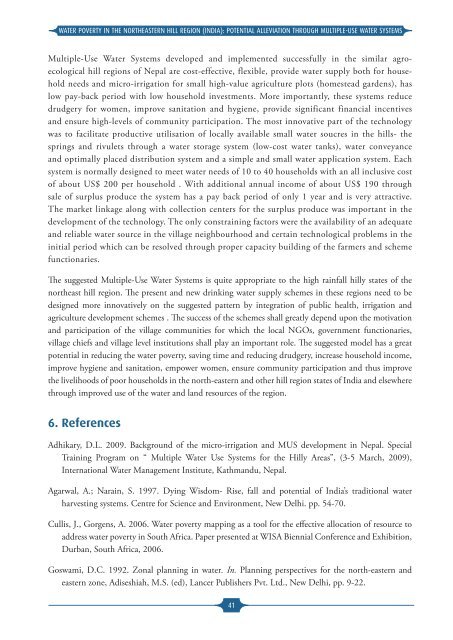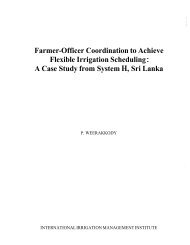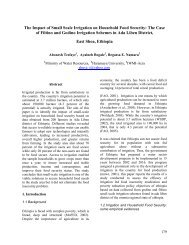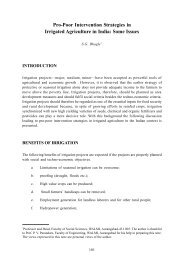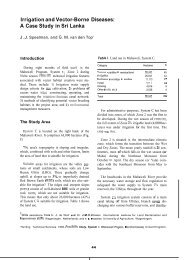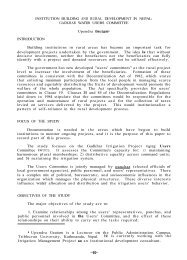WATER POVERTY IN THE NORTHEASTERN HILL REGION (INDIA)
WATER POVERTY IN THE NORTHEASTERN HILL REGION (INDIA)
WATER POVERTY IN THE NORTHEASTERN HILL REGION (INDIA)
Create successful ePaper yourself
Turn your PDF publications into a flip-book with our unique Google optimized e-Paper software.
<strong>WATER</strong> <strong>POVERTY</strong> <strong>IN</strong> <strong>THE</strong> NOR<strong>THE</strong>ASTERN <strong>HILL</strong> <strong>REGION</strong> (<strong>IN</strong>DIA): POTENTIAL ALLEVIATION THROUGH MULTIPLE-USE <strong>WATER</strong> SYSTEMSMultiple-Use Water Systems developed and implemented successfully in the similar agroecologicalhill regions of Nepal are cost-effective, flexible, provide water supply both for householdneeds and micro-irrigation for small high-value agriculture plots (homestead gardens), haslow pay-back period with low household investments. More importantly, these systems reducedrudgery for women, improve sanitation and hygiene, provide significant financial incentivesand ensure high-levels of community participation. The most innovative part of the technologywas to facilitate productive utilisation of locally available small water soucres in the hills- thesprings and rivulets through a water storage system (low-cost water tanks), water conveyanceand optimally placed distribution system and a simple and small water application system. Eachsystem is normally designed to meet water needs of 10 to 40 households with an all inclusive costof about US$ 200 per household . With additional annual income of about US$ 190 throughsale of surplus produce the system has a pay back period of only 1 year and is very attractive.The market linkage along with collection centers for the surplus produce was important in thedevelopment of the technology. The only constraining factors were the availability of an adequateand reliable water source in the village neighbourhood and certain technological problems in theinitial period which can be resolved through proper capacity building of the farmers and schemefunctionaries.The suggested Multiple-Use Water Systems is quite appropriate to the high rainfall hilly states of thenortheast hill region. The present and new drinking water supply schemes in these regions need to bedesigned more innovatively on the suggested pattern by integration of public health, irrigation andagriculture development schemes . The success of the schemes shall greatly depend upon the motivationand participation of the village communities for which the local NGOs, government functionaries,village chiefs and village level institutions shall play an important role. The suggested model has a greatpotential in reducing the water poverty, saving time and reducing drudgery, increase household income,improve hygiene and sanitation, empower women, ensure community participation and thus improvethe livelihoods of poor households in the north-eastern and other hill region states of India and elsewherethrough improved use of the water and land resources of the region.6. ReferencesAdhikary, D.L. 2009. Background of the micro-irrigation and MUS development in Nepal. SpecialTraining Program on “ Multiple Water Use Systems for the Hilly Areas”, (3-5 March, 2009),International Water Management Institute, Kathmandu, Nepal.Agarwal, A.; Narain, S. 1997. Dying Wisdom- Rise, fall and potential of India’s traditional waterharvesting systems. Centre for Science and Environment, New Delhi. pp. 54-70.Cullis, J., Gorgens, A. 2006. Water poverty mapping as a tool for the effective allocation of resource toaddress water poverty in South Africa. Paper presented at WISA Biennial Conference and Exhibition,Durban, South Africa, 2006.Goswami, D.C. 1992. Zonal planning in water. In. Planning perspectives for the north-eastern andeastern zone, Adiseshiah, M.S. (ed), Lancer Publishers Pvt. Ltd., New Delhi, pp. 9-22.41


